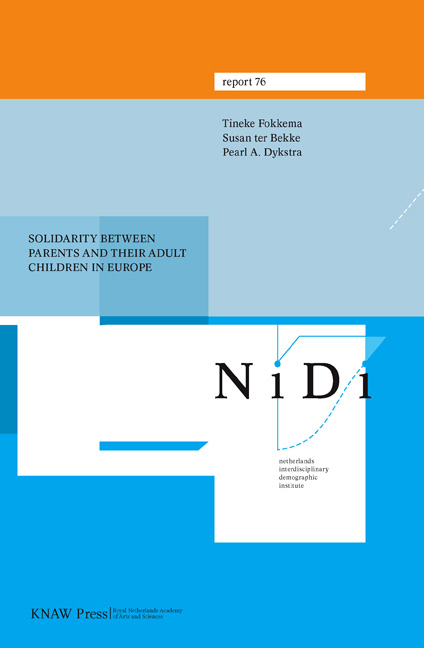Book contents
- Frontmatter
- Contents
- List of Figures
- List of Tables
- Executive Summary
- Acknowledgement
- 1 Introduction
- 2 Geographical Proximity
- 3 Contacts
- 4 Family Care Obligations
- 5 Support Exchange
- 6 Typology of Late-Life Families
- 7 Conclusion and Discussion
- References
- Appendix Measurement of the Independent Variables
- List of NIDI Reports
7 - Conclusion and Discussion
Published online by Cambridge University Press: 20 January 2021
- Frontmatter
- Contents
- List of Figures
- List of Tables
- Executive Summary
- Acknowledgement
- 1 Introduction
- 2 Geographical Proximity
- 3 Contacts
- 4 Family Care Obligations
- 5 Support Exchange
- 6 Typology of Late-Life Families
- 7 Conclusion and Discussion
- References
- Appendix Measurement of the Independent Variables
- List of NIDI Reports
Summary
Introduction
Families in Europe have changed considerably in recent decades, in both structural and cultural terms. The most important changes in family structure are the verticalisation and horizontal narrowing of families (Bengtson, 2001; Bengtson et al., 1990; Farkas & Hogan, 1995; Harper, 2005; Hogan et al., 1993; Seltzer et al., 2005): as life expectancy is rising, families today span a larger number of generations, but due to the declining family size, each successive generation consists of fewer people. We also see that family and marital ties have become weaker. Marriage has lost ground to other living arrangements, divorce is on the rise and, due to growing geographic mobility, family members are living further apart from each other (Allan et al., 2001; Kiernan, 2004). At the same time, caring duties have come under increasing pressure as a result of the emancipation of women, in particular their increased enrolment in education and labour force participation (Blossfeld, 1995; Blossfeld & Huinink, 1991; Hakim, 2000). In cultural terms there has been a shift from instrumental orientation towards the family to a more individualistic and affective orientation and a greater emphasis on individual needs and personal happiness (Hareven, 1995).
According to some, these changes are a threat to family solidarity (Popenoe, 1993; Wolfe, 1989). They say that the degree to which parents and children are prepared to support and care for each other is decreasing. In this respect, the welfare state has not been of any help. The need for children to care for their parents has declined as formal care for the elderly has been extended (Lingsom, 1997; Künemund & Rein, 1999). Benefits such as state and other pensions and social security have made parents and children less dependent on each other in economic terms.
Others believe that family solidarity has not so much weakened, but has changed in character. Smaller families and the disappearance of distance-creating parental authority have paved the way for more intensive and more personal contact between parents and their children. They say that formal care facilities for older adults and caring for one's family are complementary: as part of the caring responsibilities are taken off their shoulders, informal carers are relieved somewhat of this heavy burden and are able to keep up these duties for a longer period of time (Attias-Donfut et al., 2005a; Chappell & Blandford, 1991; Daatland & Herlofson, 2001).
- Type
- Chapter
- Information
- Publisher: Amsterdam University PressPrint publication year: 2008



